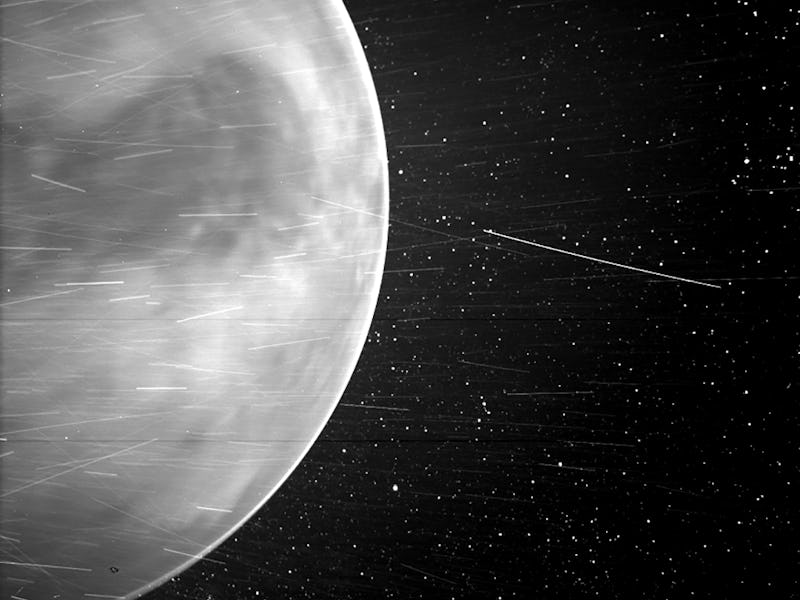NASA’s Parker Solar Probe just detected something fascinating just above Venus
The accidental brush with Venus' upper atmosphere was the first direct measurement in nearly 30 years — and could unravel why it’s so different from Earth.

On July 11, 2020, a small spacecraft flew by the scorching hot planet Venus while traveling through space on its way to the Sun.
Down on Earth, Glyn Collinson, a researcher at NASA’s Goddard Space Flight Center and self-proclaimed “Venus nerd,” was waiting anxiously on the data being beamed down from that brief encounter between Venus and NASA’s Solar Parker Probe.
“I was basically sitting by my computer waiting for the Parker Probe to release their data and sort of spamming the refresh button,” Collinson tells Inverse.
Although he found none of the things he was originally looking for, Collison noticed a “frown” in the data. That slight frown indicated that the solar probe had done something no spacecraft had done in nearly 30 years: it had flown through Venus’ upper atmosphere.
With that accidental blip, Collinson had stumbled upon the first direct detection of the planet’s ionosphere since 1992, and discovered that the upper atmosphere changes as a result of the Sun’s 11-year cycle.
The recent findings are detailed in a study published Monday in the Geophysical Research Letters.
HERE’S WHAT HAPPENED — The Parker Solar Probe launched on August 12, 2018 with the aim of getting as close as 4 million miles from the burning hot Sun.
The craft uses the planet Venus for repeated gravity assists to get deeper toward the Sun. For its third flyby of Venus in July, the probe was at an altitude of approximately 517 miles above Venus’ surface, gathering data on Earth’s much hotter cousin while it was in the neighborhood.
Using one of its instruments, the solar probe FIELDS — which is named for the electric and magnetic fields it measures in the Sun’s atmosphere — detected a natural, low-frequency radio signal from Venus that lasted for just seven minutes.
Then came the frown.
“If you were in your car, spinning the frequency dial, it would be like quiet, quiet, then maybe one frequency where there would be a whole bunch of noise in it, and then nothing again,” Collinson says.
After sleeping on it, Collinson woke up the next day and realized what the frown was. From his previous work with NASA’s Galileo orbiter, which explored Jupiter and its moons, Collinson recalled that a similar frown appeared in 1996 whenever the spacecraft passed through the ionospheres of Jupiter’s moons.
The ionosphere is the electrically charged layer of gas at the upper edge of Venus’ atmosphere. The charged gas, or plasma, emits electromagnetic waves at radio frequencies.
“Plasmas have superpowers that other gases don't normally have,” Collinson says. “They are affected by electrical magnetic fields and they can generate them.”
Collinson and his team used this radio emission to calculate the density of the ionosphere that the Parker Solar Probe flew through.
The last time scientists were able to measure the density of Venus’ upper atmosphere was in 1992 in the final months of the Pioneer Venus Orbiter, which launched in 1978 to study the hottest planet in our Solar System.
At that time, the Sun was near its solar maximum, or the point during its 11-year cycle where it experiences increased activity marked by plasma flareups and solar wind.
But this time as the Parker Solar Probe brushed up against Venus’ atmosphere, it was during the solar minimum, where things are relatively calm. By comparing the two data sets, the researchers found that there is about 10 times less the amount of the ionosphere during the solar minimum.
“Even with one flyby, we were able to prove mathematically that there's a big difference with the solar cycle, which is very tantalizing,” Collinson says.
So, what does that mean? This recent measurement of Venus’ ionosphere helps scientists understand this elusive planet, which has a similar size and structure to Earth but is plagued by scorching hot temperatures that reach up to 900 degrees Fahrenheit.
Earth and Venus started off very similar, but evolved into two very different worlds.
Scientists believe that the Earth and Venus started off as remarkably similar rocky planets that evolved in very different ways. While Earth became a haven for life, Venus became a vision of hell. What caused those two planets to be so different is one of the biggest puzzles of the Solar System.
But by understanding how Venus responds to the Sun’s activity, scientists may unravel one piece of the puzzle.
But for now, Collinson is not leaning towards one theory over the other when it comes to why Venus’ ionosphere would be responding that way to the Sun’s cycle.
“I’ll stay agnostic on this, I don’t think we have enough data,” Collinson says.
What’s next — Collinson and his fellow “Venus nerds” would like to see more missions sent out to our neighboring planet so that scientists can gather enough data on Venus and dissect it in the granular detail we’ve been able to draw out from Mars.
“It wouldn’t be hard,” Collinson says. “We could understand the evolution of Venus’ water and how its atmosphere interacts with solar wind with a spacecraft similar to the ones sent to Mars.”
The Pioneer mission was the last one to probe at Venus’ atmosphere, and it did so with 1970’s era scientific instruments.
“We could go back and do a lot of these things with modern instruments so we can really solve a lot of these problems,” Collinson says. “But the difficulty is with the will to do that.”
This article was originally published on